Animation of the relative sizes of the planets compared to the Sun, in order of their size, and then even larger stars. The animation starts with the smallest planet, Mercury, with a diameter of 4880 kilometres km. Next is Mars, at 6792km. Venus is next, with a diameter of 12,100km. Venus is often considered a sister planet to Earth, as our planet is only slightly larger, at 12,742km. These four planets are all relatively close to the Sun, and are all largely made of rock. The next largest planet after Earth is the distant ice giant Neptune, some 49,500km across, and composed mostly of gas and ices. Its sister planet Uranus is only slightly larger, at just over 51,000km. After these two ice giants comes the gas giant Saturn, just over 120,500km across, with major rings some 280,000 kilometres in diameter there are fainter rings even further out. The largest planet in the solar system is Jupiter, some 143,000 kilometres across at the equator. Jupiter is also by far the most massive planet, 318 times the mass of the Earth, and 2.5 times the mass of all the other planets combined. The Sun dwarfs all the planets, having 1000 times Jupiter磗 mass, and a diameter of 1,392,000km. Although the Sun is huge compared to the planets, it is a small star. The view pulls back to show the white star Sirius Alpha Canis Majoris, which is 1.7 times the size of the Sun. Next is the orange giant Arcturus Alpha Bootis, 26 times the Sun磗 size. The yellow circles visible are the orbits of the planets in the solar system, with Mercury innermost, Venus and Earth磗 orbits visible at this stage. Next is the red giant Aldebaran Alpha Tauri, 44 times the Sun磗 size, and the orbit of Mars appears. After this is the blue supergiant Rigel Beta Orionis, some 78 times the size of the Sun, larger than the orbit of Mercury. This immensely powerful star is the sixth brightest in the sky, despite its distance of some 900 light years. After this is Betelgeuse Alpha Orionis, an enormous red supergiant some 1180 times the Sun磗 diameter, which would stretch almost to the orbit of Jupiter if it were in the Sun磗 place. Even that giant star is surpassed by the vast VY Canis Majoris, the largest star known. It is a red hypergiant thought to have a diameter some 2000 times that of the Sun _ if in the centre of the solar system, it would extend past the orbit of Saturn. The orbit of Uranus is the outermost one seen at this stage.
Details
WebID:
C00608703
Clip Type:
RM
Super High Res Size:
1920X1080
Duration:
000:57.000
Format:
QuickTime
Bit Rate:
25 fps
Available:
download
Comp:
200X112 (0.00 M)
Model Release:
NO
Property Release
No

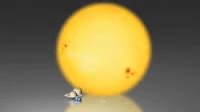

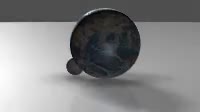



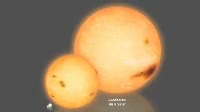
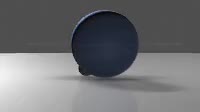
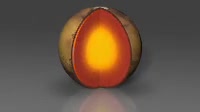



 Loading
Loading